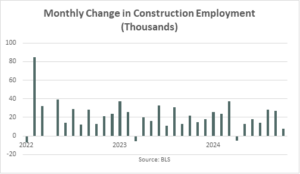by Arsene Aka, Senior Economist at Dodge Construction Network
The final report of the Bureau of Labor Statistics (BLS) before the U.S. elections shows that the economy added 12,000 new jobs in October, the weakest pace since December 2020, down from a September gain of 223,000. The moderation in job gains is not surprising: one-off events such as the Boeing strike and the devastations from Hurricane Helene and Milton have adversely impacted job growth. Economists estimate these events to have subtracted more than 100,000 jobs from the October payrolls. In addition to last month’s weak job growth, the BLS also revised down August and September job gains by a total of 112,000. Meanwhile, the unemployment rate—derived from a different survey than the employment figures—held steady at 4.1%, in line with economists’ expectations. Finally, U.S. wage growth—captured by the average hourly earnings for all U.S. employees on private nonfarm payrolls—accelerated to 4.0% year-over-year (y/y) last month, from 3.9% y/y in September.
Construction employment rose 8,000 in October, easing from 27,000 new jobs in the prior month and an average monthly gain of 20,000 recorded over the prior twelve months. Over the month, employment rose in residential and nonresidential building construction and nonresidential specialty trade contractors. On the other hand, monthly employment fell in residential specialty trade contractors and heavy and civil engineering construction sector. Wage growth decelerated to 4.6% y/y last month, from 4.8% y/y in September. Meanwhile, the jobless rate in the construction industry at 4.2% continued its ascent in October and now stands above the nation’s.
The BLS report is consistent with additional monetary easing by the Federal Reserve Bank at its next, November meeting. Dodge Construction Network expects the Fed will cut interest rates by 25 basis points in November after a larger than expected 50 basis point cut in September, which was the first rate cut since 2020. Dodge expects further 25 bps rate cuts in December and in each quarter of 2025. Such a monetary policy outlook bodes well for the construction sector in 2024-25.

